brake fluid Seat Ibiza ST 2012 User Guide
[x] Cancel search | Manufacturer: SEAT, Model Year: 2012, Model line: Ibiza ST, Model: Seat Ibiza ST 2012Pages: 282, PDF Size: 3.77 MB
Page 215 of 282
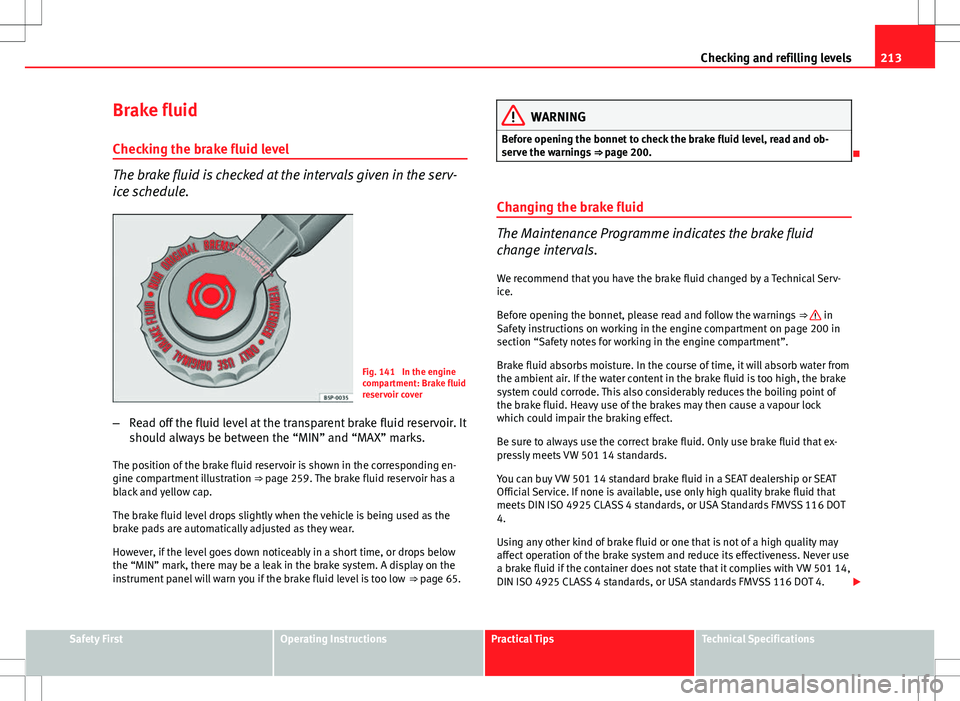
213
Checking and refilling levels
Brake fluid Checking the brake fluid level
The brake fluid is checked at the intervals given in the serv-
ice schedule.
Fig. 141 In the engine
compartment: Brake fluid
reservoir cover
– Read off the fluid level at the transparent brake fluid reservoir. It
should always be between the “MIN” and “MAX” marks.
The position of the brake fluid reservoir is shown in the corresponding en-
gine compartment illustration ⇒ page 259. The brake fluid reservoir has a
black and yellow cap.
The brake fluid level drops slightly when the vehicle is being used as the
brake pads are automatically adjusted as they wear.
However, if the level goes down noticeably in a short time, or drops below
the “MIN” mark, there may be a leak in the brake system. A display on the
instrument panel will warn you if the brake fluid level is too low ⇒ page 65.
WARNING
Before opening the bonnet to check the brake fluid level, read and ob-
serve the warnings ⇒ page 200.
Changing the brake fluid
The Maintenance Programme indicates the brake fluid
change intervals. We recommend that you have the brake fluid changed by a Technical Serv-
ice.
Before opening the bonnet, please read and follow the warnings ⇒
in
Safety instructions on working in the engine compartment on page 200 in
section “Safety notes for working in the engine compartment”.
Brake fluid absorbs moisture. In the course of time, it will absorb water from
the ambient air. If the water content in the brake fluid is too high, the brake
system could corrode. This also considerably reduces the boiling point of
the brake fluid. Heavy use of the brakes may then cause a vapour lock
which could impair the braking effect.
Be sure to always use the correct brake fluid. Only use brake fluid that ex-
pressly meets VW 501 14 standards.
You can buy VW 501 14 standard brake fluid in a SEAT dealership or SEAT
Official Service. If none is available, use only high quality brake fluid that
meets DIN ISO 4925 CLASS 4 standards, or USA Standards FMVSS 116 DOT
4.
Using any other kind of brake fluid or one that is not of a high quality may
affect operation of the brake system and reduce its effectiveness. Never use
a brake fluid if the container does not state that it complies with VW 501 14,
DIN ISO 4925 CLASS 4 standards, or USA standards FMVSS 116 DOT 4.
Safety FirstOperating InstructionsPractical TipsTechnical Specifications
Page 216 of 282
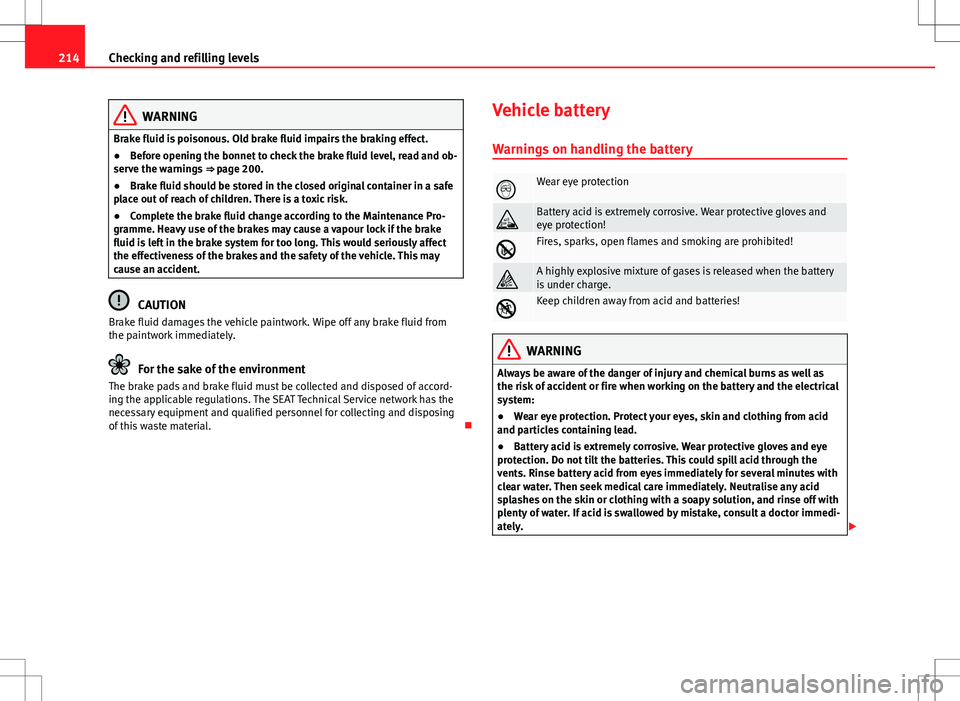
214Checking and refilling levels
WARNING
Brake fluid is poisonous. Old brake fluid impairs the braking effect.
● Before opening the bonnet to check the brake fluid level, read and ob-
serve the warnings ⇒ page 200.
● Brake fluid should be stored in the closed original container in a safe
place out of reach of children. There is a toxic risk.
● Complete the brake fluid change according to the Maintenance Pro-
gramme. Heavy use of the brakes may cause a vapour lock if the brake
fluid is left in the brake system for too long. This would seriously affect
the effectiveness of the brakes and the safety of the vehicle. This may
cause an accident.
CAUTION
Brake fluid damages the vehicle paintwork. Wipe off any brake fluid from
the paintwork immediately.
For the sake of the environment
The brake pads and brake fluid must be collected and disposed of accord-
ing the applicable regulations. The SEAT Technical Service network has the
necessary equipment and qualified personnel for collecting and disposing
of this waste material. Vehicle battery
Warnings on handling the battery
Wear eye protection
Battery acid is extremely corrosive. Wear protective gloves and
eye protection!
Fires, sparks, open flames and smoking are prohibited!
A highly explosive mixture of gases is released when the battery
is under charge.
Keep children away from acid and batteries!
WARNING
Always be aware of the danger of injury and chemical burns as well as
the risk of accident or fire when working on the battery and the electrical
system:
● Wear eye protection. Protect your eyes, skin and clothing from acid
and particles containing lead.
● Battery acid is extremely corrosive. Wear protective gloves and eye
protection. Do not tilt the batteries. This could spill acid through the
vents. Rinse battery acid from eyes immediately for several minutes with
clear water. Then seek medical care immediately. Neutralise any acid
splashes on the skin or clothing with a soapy solution, and rinse off with
plenty of water. If acid is swallowed by mistake, consult a doctor immedi-
ately.
Page 221 of 282
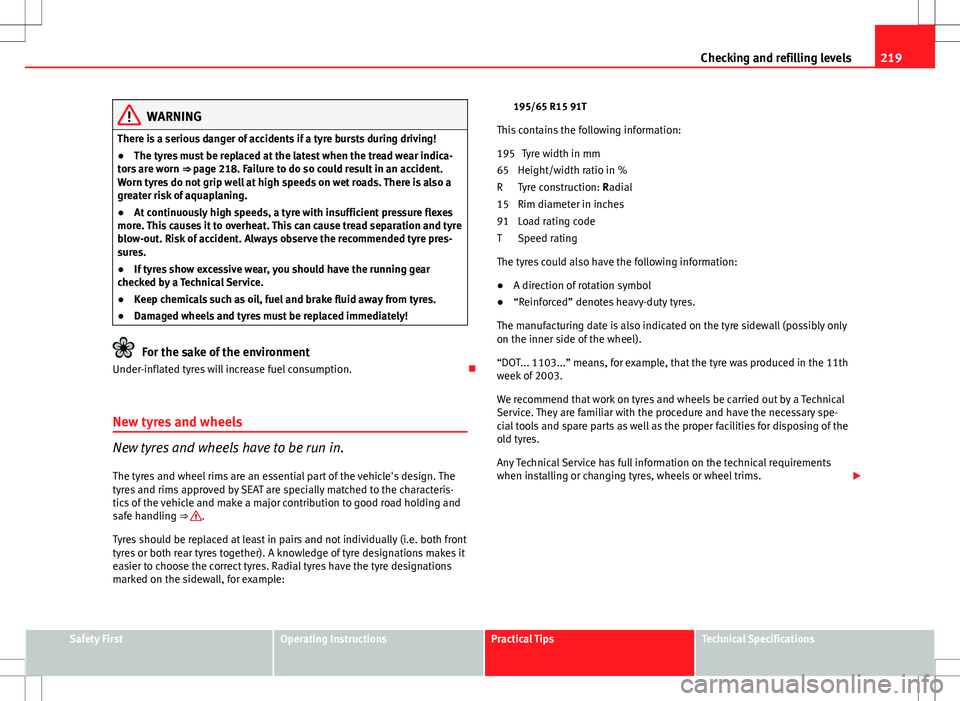
219
Checking and refilling levels
WARNING
There is a serious danger of accidents if a tyre bursts during driving!
● The tyres must be replaced at the latest when the tread wear indica-
tors are worn ⇒ page 218. Failure to do so could result in an accident.
Worn tyres do not grip well at high speeds on wet roads. There is also a
greater risk of aquaplaning.
● At continuously high speeds, a tyre with insufficient pressure flexes
more. This causes it to overheat. This can cause tread separation and tyre
blow-out. Risk of accident. Always observe the recommended tyre pres-
sures.
● If tyres show excessive wear, you should have the running gear
checked by a Technical Service.
● Keep chemicals such as oil, fuel and brake fluid away from tyres.
● Damaged wheels and tyres must be replaced immediately!
For the sake of the environment
Under-inflated tyres will increase fuel consumption.
New tyres and wheels
New tyres and wheels have to be run in.
The tyres and wheel rims are an essential part of the vehicle's design. The
tyres and rims approved by SEAT are specially matched to the characteris-
tics of the vehicle and make a major contribution to good road holding and
safe handling ⇒
.
Tyres should be replaced at least in pairs and not individually (i.e. both front
tyres or both rear tyres together). A knowledge of tyre designations makes it
easier to choose the correct tyres. Radial tyres have the tyre designations
marked on the sidewall, for example: 195/65 R15 91T
This contains the following information: Tyre width in mm
Height/width ratio in %
Tyre construction: Radial
Rim diameter in inches
Load rating code
Speed rating
The tyres could also have the following information:
● A direction of rotation symbol
● “Reinforced” denotes heavy-duty tyres.
The manufacturing date is also indicated on the tyre sidewall (possibly only
on the inner side of the wheel).
“DOT... 1103...” means, for example, that the tyre was produced in the 11th
week of 2003.
We recommend that work on tyres and wheels be carried out by a Technical
Service. They are familiar with the procedure and have the necessary spe-
cial tools and spare parts as well as the proper facilities for disposing of the
old tyres.
Any Technical Service has full information on the technical requirements
when installing or changing tyres, wheels or wheel trims.
195
65
R
15
91
T
Safety FirstOperating InstructionsPractical TipsTechnical Specifications
Page 261 of 282
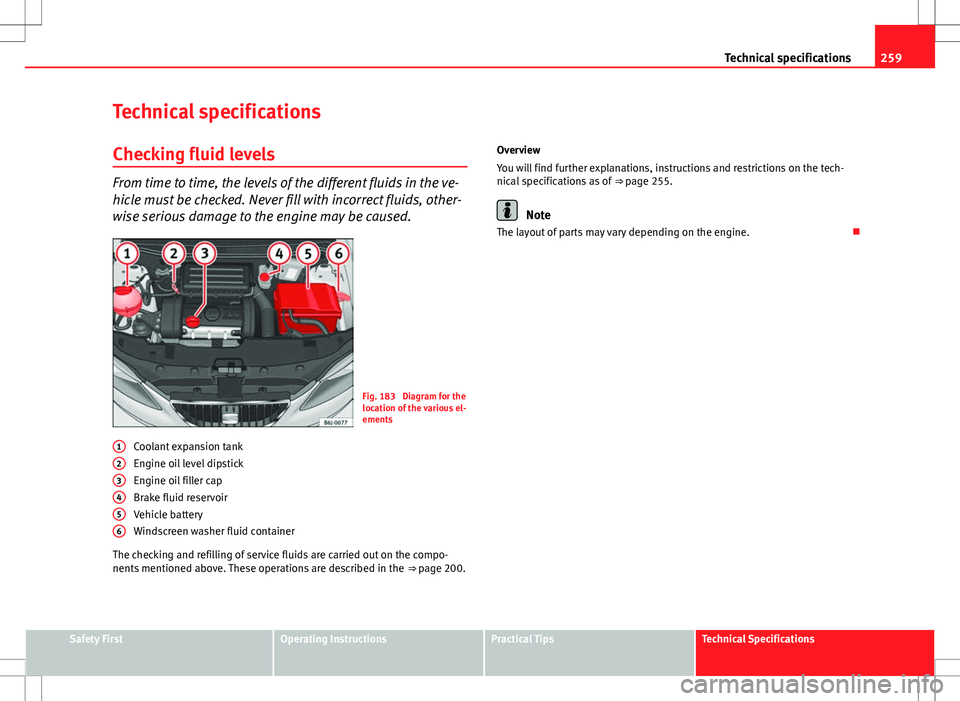
259
Technical specifications
Technical specifications
Checking fluid levels
From time to time, the levels of the different fluids in the ve-
hicle must be checked. Never fill with incorrect fluids, other-
wise serious damage to the engine may be caused.
Fig. 183 Diagram for the
location of the various el-
ements
Coolant expansion tank
Engine oil level dipstick
Engine oil filler cap
Brake fluid reservoir
Vehicle battery
Windscreen washer fluid container
The checking and refilling of service fluids are carried out on the compo-
nents mentioned above. These operations are described in the ⇒ page 200.
1
23456
Overview
You will find further explanations, instructions and restrictions on the tech-
nical specifications as of
⇒ page 255.
Note
The layout of parts may vary depending on the engine.
Safety FirstOperating InstructionsPractical TipsTechnical Specifications
Page 273 of 282
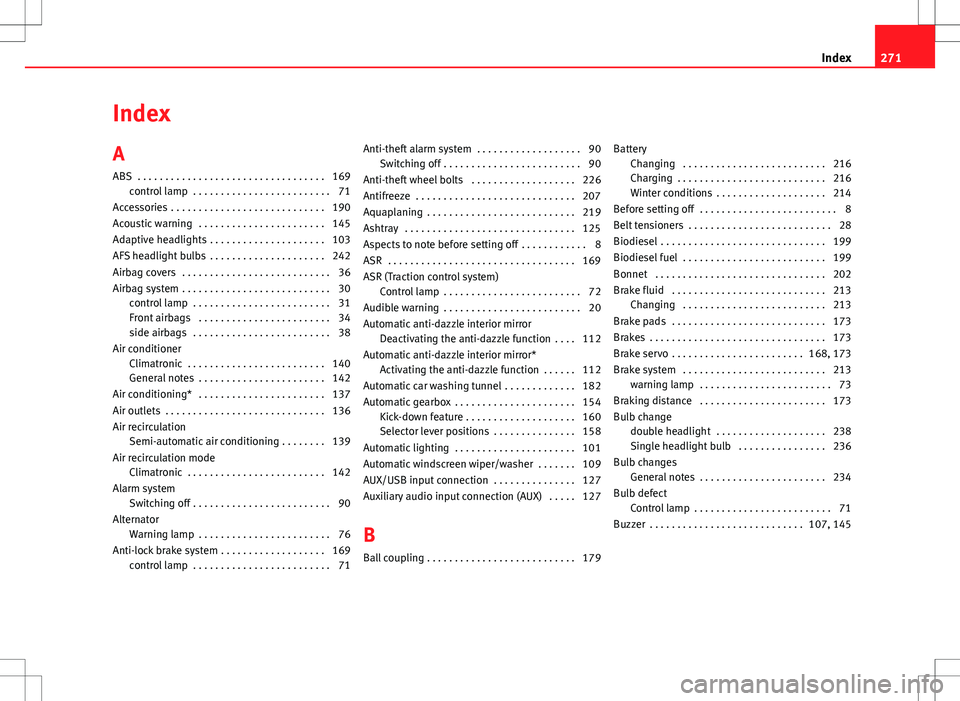
Index
A
ABS . . . . . . . . . . . . . . . . . . . . . . . . . . . . . . . . . . 169control lamp . . . . . . . . . . . . . . . . . . . . . . . . . 71
Accessories . . . . . . . . . . . . . . . . . . . . . . . . . . . . 190
Acoustic warning . . . . . . . . . . . . . . . . . . . . . . . 145
Adaptive headlights . . . . . . . . . . . . . . . . . . . . . 103
AFS headlight bulbs . . . . . . . . . . . . . . . . . . . . . 242
Airbag covers . . . . . . . . . . . . . . . . . . . . . . . . . . . 36
Airbag system . . . . . . . . . . . . . . . . . . . . . . . . . . . 30 control lamp . . . . . . . . . . . . . . . . . . . . . . . . . 31
Front airbags . . . . . . . . . . . . . . . . . . . . . . . . 34
side airbags . . . . . . . . . . . . . . . . . . . . . . . . . 38
Air conditioner Climatronic . . . . . . . . . . . . . . . . . . . . . . . . . 140
General notes . . . . . . . . . . . . . . . . . . . . . . . 142
Air conditioning* . . . . . . . . . . . . . . . . . . . . . . . 137
Air outlets . . . . . . . . . . . . . . . . . . . . . . . . . . . . . 136
Air recirculation Semi-automatic air conditioning . . . . . . . . 139
Air recirculation mode Climatronic . . . . . . . . . . . . . . . . . . . . . . . . . 142
Alarm system Switching off . . . . . . . . . . . . . . . . . . . . . . . . . 90
Alternator Warning lamp . . . . . . . . . . . . . . . . . . . . . . . . 76
Anti-lock brake system . . . . . . . . . . . . . . . . . . . 169 control lamp . . . . . . . . . . . . . . . . . . . . . . . . . 71 Anti-theft alarm system . . . . . . . . . . . . . . . . . . . 90
Switching off . . . . . . . . . . . . . . . . . . . . . . . . . 90
Anti-theft wheel bolts . . . . . . . . . . . . . . . . . . . 226
Antifreeze . . . . . . . . . . . . . . . . . . . . . . . . . . . . . 207
Aquaplaning . . . . . . . . . . . . . . . . . . . . . . . . . . . 219
Ashtray . . . . . . . . . . . . . . . . . . . . . . . . . . . . . . . 125
Aspects to note before setting off . . . . . . . . . . . . 8
ASR . . . . . . . . . . . . . . . . . . . . . . . . . . . . . . . . . . 169
ASR (Traction control system) Control lamp . . . . . . . . . . . . . . . . . . . . . . . . . 72
Audible warning . . . . . . . . . . . . . . . . . . . . . . . . . 20
Automatic anti-dazzle interior mirror Deactivating the anti-dazzle function . . . . 112
Automatic anti-dazzle interior mirror* Activating the anti-dazzle function . . . . . . 112
Automatic car washing tunnel . . . . . . . . . . . . . 182
Automatic gearbox . . . . . . . . . . . . . . . . . . . . . . 154 Kick-down feature . . . . . . . . . . . . . . . . . . . . 160
Selector lever positions . . . . . . . . . . . . . . . 158
Automatic lighting . . . . . . . . . . . . . . . . . . . . . . 101
Automatic windscreen wiper/washer . . . . . . . 109
AUX/USB input connection . . . . . . . . . . . . . . . 127
Auxiliary audio input connection (AUX) . . . . . 127
B
Ball coupling . . . . . . . . . . . . . . . . . . . . . . . . . . . 179 Battery
Changing . . . . . . . . . . . . . . . . . . . . . . . . . . 216
Charging . . . . . . . . . . . . . . . . . . . . . . . . . . . 216
Winter conditions . . . . . . . . . . . . . . . . . . . . 214
Before setting off . . . . . . . . . . . . . . . . . . . . . . . . . 8
Belt tensioners . . . . . . . . . . . . . . . . . . . . . . . . . . 28
Biodiesel . . . . . . . . . . . . . . . . . . . . . . . . . . . . . . 199
Biodiesel fuel . . . . . . . . . . . . . . . . . . . . . . . . . . 199
Bonnet . . . . . . . . . . . . . . . . . . . . . . . . . . . . . . . 202
Brake fluid . . . . . . . . . . . . . . . . . . . . . . . . . . . . 213 Changing . . . . . . . . . . . . . . . . . . . . . . . . . . 213
Brake pads . . . . . . . . . . . . . . . . . . . . . . . . . . . . 173
Brakes . . . . . . . . . . . . . . . . . . . . . . . . . . . . . . . . 173
Brake servo . . . . . . . . . . . . . . . . . . . . . . . . 168, 173
Brake system . . . . . . . . . . . . . . . . . . . . . . . . . . 213 warning lamp . . . . . . . . . . . . . . . . . . . . . . . . 73
Braking distance . . . . . . . . . . . . . . . . . . . . . . . 173
Bulb change double headlight . . . . . . . . . . . . . . . . . . . . 238
Single headlight bulb . . . . . . . . . . . . . . . . 236
Bulb changes General notes . . . . . . . . . . . . . . . . . . . . . . . 234
Bulb defect Control lamp . . . . . . . . . . . . . . . . . . . . . . . . . 71
Buzzer . . . . . . . . . . . . . . . . . . . . . . . . . . . . 107, 145
271
Index